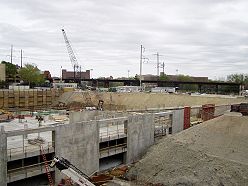Philadelphia Convention Hall and Civic Center
This article needs additional citations for verification. (September 2022) |
"The Nation's Most Historic Arena" | |
| (NCAA) (1989–1996) |
The Philadelphia Convention Hall and Civic Center, commonly known simply as the Philadelphia Civic Center, was a convention center complex located in Philadelphia, Pennsylvania. It developed out of a series of buildings dedicated to expanding trade which began with the National Export Exhibition in 1899. The two most significant buildings in the complex were the original main exhibition hall built in 1899, which later housed the Philadelphia Commercial Museum, and the Municipal Auditorium, later called the Convention Hall, which was built in 1931 to the designers of architect Philip H. Johnson. The site was host to national political conventions in 1900, 1936, 1940 and 1948.
Location
The Convention Hall arena was located at 3400 Civic Center Boulevard, on the edge of the campus of the University of Pennsylvania, and just to the southwest of Franklin Field. It was built in 1930 and its highest capacity was approximately 12,000. The building was an Art Deco landmark, notable for its many friezes and other decorative aspects.
Arena history
1930–1966
Originally known as the Municipal Auditorium, the arena hosted many events, including the 1936 and 1948
President
1967–2005
After the

Convention Hall was torn down in 2005, after more than a decade without a regular tenant. The 1996
The Auditorium's M.P. Moller 86-rank
The last remnant of the Civic Center, Pennsylvania Hall (built in 1978), was imploded on March 4, 2007. The University of Pennsylvania Health System's Perelman Center for Advanced Medicine opened on the site in October 2008.
One limestone frieze that adorned the Civic Center, 5 feet (1.5 m) tall and 48 feet (15 m) long and depicting the history of labor from the days of the ancient Egyptians to the 20th century, was carefully removed before the building was demolished.[7] It was purchased by the Alessi Organization in 2005 and in 2017 was installed outside its new Crossing Shopping Center at East 22nd Street and Route 440 in Bayonne, New Jersey.[8]
References
- ^ 1634–1699: McCusker, J. J. (1997). How Much Is That in Real Money? A Historical Price Index for Use as a Deflator of Money Values in the Economy of the United States: Addenda et Corrigenda (PDF). American Antiquarian Society. 1700–1799: McCusker, J. J. (1992). How Much Is That in Real Money? A Historical Price Index for Use as a Deflator of Money Values in the Economy of the United States (PDF). American Antiquarian Society. 1800–present: Federal Reserve Bank of Minneapolis. "Consumer Price Index (estimate) 1800–". Retrieved February 29, 2024.
- ^ Woolley, John T.; Gerhard Peters. "Remarks in Convention Hall, Philadelphia. August 29, 1964". The American Presidency Project. Retrieved 2008-12-30.
- ^ Valania, Jonathan (2004-04-28). "A Hard Night's Day: Forty years ago the Beatles came to Philadelphia. And nothing would ever be the same". Philadelphia Weekly. Archived from the original on October 25, 2007. Retrieved 2008-12-30.
- ^ "American Spring Tour, 1965". frayed.org. Retrieved 2008-12-30.
- ^ Brinkman, Bennett (24 November 2019). "'Unique in the nation': American Organ Institute students, alumni reflect on program ahead of closure". OUdaily.com. Norman, Oklahoma: University of Oklahoma. Retrieved 6 July 2023.
- ^ "American Organ Institute Originally M. P. Möller (Opus 5819, 1931)". Pipe Organ Database. Organ Historical Society. Retrieved 6 July 2023.
- ^ Hargis, Lucianna (January 29, 2019). "Historic Limestone Friezes from Philadelphia Civic Center". Olde Good Things. Retrieved June 27, 2020.
- ^ Keller, Kristen (November 25, 2017). "Nearly century-old work of art perfect fit for working-class Bayonne". The Jersey Journal. Retrieved November 25, 2017.
Further reading
- Hunter, Ruth (1962). The Trade and Convention Center of Philadelphia: Its Birth and Renascence. Philadelphia: The City of Philadelphia.
External links
- Dedication booklet Archived 2011-07-20 at the Wayback Machine
- Information on Moller Opus 5819 now at the University of Oklahoma's School of Music, American Organ Institute Archived 2011-07-20 at the Wayback Machine
- Photos of the Civic Center prior to destruction including details of the preservation efforts
- Philadelphia Player Article
- Philadelphia Boxing History at Convention Hall
